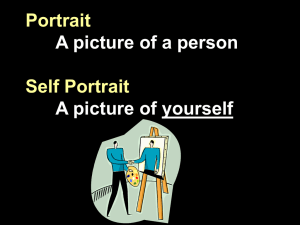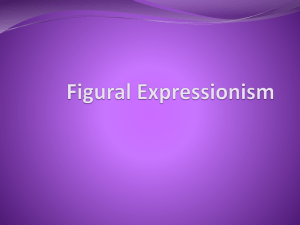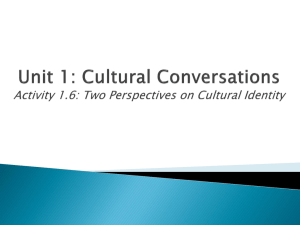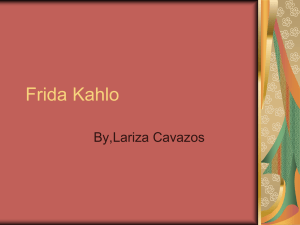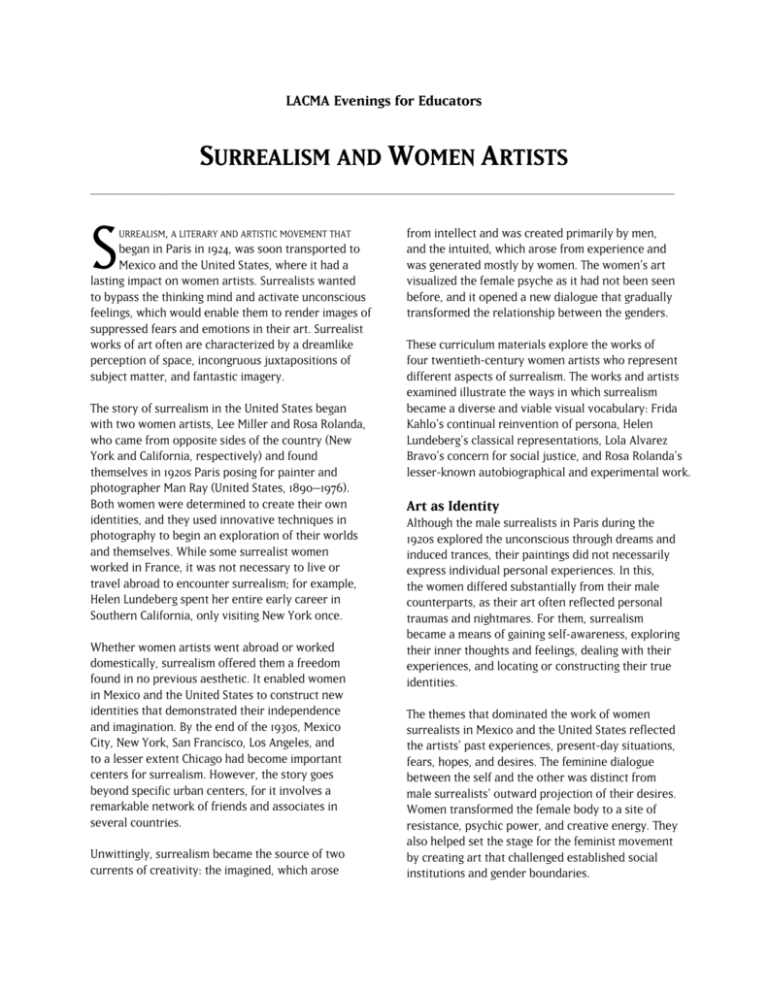
LACMA Evenings for Educators
SURREALISM AND WOMEN ARTISTS
___________________________________________________________________________________________________________________________________________________
S
URREALISM, A LITERARY AND ARTISTIC MOVEMENT THAT
began in Paris in 1924, was soon transported to
Mexico and the United States, where it had a
lasting impact on women artists. Surrealists wanted
to bypass the thinking mind and activate unconscious
feelings, which would enable them to render images of
suppressed fears and emotions in their art. Surrealist
works of art often are characterized by a dreamlike
perception of space, incongruous juxtapositions of
subject matter, and fantastic imagery.
The story of surrealism in the United States began
with two women artists, Lee Miller and Rosa Rolanda,
who came from opposite sides of the country (New
York and California, respectively) and found
themselves in 1920s Paris posing for painter and
photographer Man Ray (United States, 1890–1976).
Both women were determined to create their own
identities, and they used innovative techniques in
photography to begin an exploration of their worlds
and themselves. While some surrealist women
worked in France, it was not necessary to live or
travel abroad to encounter surrealism; for example,
Helen Lundeberg spent her entire early career in
Southern California, only visiting New York once.
Whether women artists went abroad or worked
domestically, surrealism offered them a freedom
found in no previous aesthetic. It enabled women
in Mexico and the United States to construct new
identities that demonstrated their independence
and imagination. By the end of the 1930s, Mexico
City, New York, San Francisco, Los Angeles, and
to a lesser extent Chicago had become important
centers for surrealism. However, the story goes
beyond specific urban centers, for it involves a
remarkable network of friends and associates in
several countries.
Unwittingly, surrealism became the source of two
currents of creativity: the imagined, which arose
from intellect and was created primarily by men,
and the intuited, which arose from experience and
was generated mostly by women. The women’s art
visualized the female psyche as it had not been seen
before, and it opened a new dialogue that gradually
transformed the relationship between the genders.
These curriculum materials explore the works of
four twentieth-century women artists who represent
different aspects of surrealism. The works and artists
examined illustrate the ways in which surrealism
became a diverse and viable visual vocabulary: Frida
Kahlo’s continual reinvention of persona, Helen
Lundeberg’s classical representations, Lola Alvarez
Bravo’s concern for social justice, and Rosa Rolanda’s
lesser-known autobiographical and experimental work.
Art as Identity
Although the male surrealists in Paris during the
1920s explored the unconscious through dreams and
induced trances, their paintings did not necessarily
express individual personal experiences. In this,
the women differed substantially from their male
counterparts, as their art often reflected personal
traumas and nightmares. For them, surrealism
became a means of gaining self-awareness, exploring
their inner thoughts and feelings, dealing with their
experiences, and locating or constructing their true
identities.
The themes that dominated the work of women
surrealists in Mexico and the United States reflected
the artists’ past experiences, present-day situations,
fears, hopes, and desires. The feminine dialogue
between the self and the other was distinct from
male surrealists’ outward projection of their desires.
Women transformed the female body to a site of
resistance, psychic power, and creative energy. They
also helped set the stage for the feminist movement
by creating art that challenged established social
institutions and gender boundaries.
The Role of Portraiture in Surrealism
Because much of the art of women surrealists was
self-referential in nature, portraiture was an ideal
vehicle for exploring identity. Within that genre,
self-portraits were essential, whether they were
presented as straightforward depictions, autobiographical or fabricated stories, or symbolic still lifes.
Since the time of the Egyptians, portraits have
served as documents that record an individual’s
likeness at a particular moment in time. While
traditional portraiture provided information and
clues about the sitter’s characteristics, interests,
social status, or history, women artists in the
surrealist movement approached portraits and selfportraits in a nontraditional manner, as exemplified
by the works of Frida Kahlo, Rosa Rolanda, and
Helen Lundeberg.
Unlike the male surrealists, women artists and
writers sought to reconstruct their identities
through the strategy of self-representation,
exploring the varieties of self-portraits through
painting and through autobiographical narrative.
They produced an astonishing number of portraits
and self-portraits. According to Museo de Arte
Moderno curator Tere Arcq, “This genre became a
form of representation ‘in which the artist is both
subject and object and conceives of how she looks
in the sense of how she sees rather than how she
appears.’”1
Surrealist artists experimented with a variety
of visual media such as painting, photography,
photogram, collage, and montage. Study the
artworks in this curriculum and think about the
messages they convey. How does the artist’s
choice of medium help express this message?
Write this message in your own words using a
literary medium such as narrative or poetry.
The Role of Photography in Surrealism
The surrealists exploited the ambiguous relationships between photography as document, as
technical experiment, and as product of the
imagination, and they did so more surely and with
greater effect than any other group of artists in the
twentieth century.
Processes such as the photogram (cameraless
photographs), which could be linked directly to
surrealist automatism or automatic writing, had a
history independent of the movement. There is no
clear demarcation within the huge repertoire of
photographic practices between the works of the
surrealists and those of other artists, and often it is
the context that situates a photograph specifically
within a surrealist frame.
Photomontage, or photocollage, had become by
the 1930s a relatively widespread technique that
was practiced by artists across numerous visual
and social movements. It became a popular medium
at the end of World War I, when it was used more
or less simultaneously by Russian and German
modernists. Artists selected the images to be
included in the photomontage, and through the
artistic device of juxtaposition expressed satire,
political views, private fantasies, or dreams of
a utopian, technological, and egalitarian future.
Practices varied enormously: artists might simply
paste a face or other fragment onto an existing
image, cut up and recombine photographs in both
positive and negative forms, cannibalize newspapers, or add captions and scraps of text. While
the surrealists combined unrelated images and
fragments to challenge preconceived notions,
the technique’s capacity to convey a message also
captivated the worlds of politics and advertising.
Consider the ways in which artists, social
documentarians such as journalists and
photojournalists, and advertisers record
contemporary life. Collect a variety of sources,
such as magazines, newspapers, and your own
photographs. Cut images, headlines, phrases,
and even fine print from these sources that catch
your eye. Think about how the artistic device of
juxtaposition, or placing incongruous imagery in
visual conversation, can help convey a message.
Arrange the pictures and text by overlapping,
underlapping, or placing them side by side to
create a composition.
Drawing Photogram, C. LATE 1920S
ROSA ROLANDA (UNITED STATES, 1895–1970, ACTIVE MEXICO)
___________________________________________________________________________________________________________________________________________________
IN THIS BLACK-AND-WHITE IMAGE, WE SEE THE NUDE FIGURE
of a young woman covered by an inverted glass,
which becomes her garment. The translucent glass
allows the curves of her figure to be seen, but it still
provides a modest covering. The shape of the glass
is reminiscent of dress styles of the mid-1800s, with
a wide hooped skirt and narrow waistline.
To make a photogram, objects are placed onto
photosensitive paper; direct sunlight develops the
imagery. The earliest examples of this experimental
technique can be dated to the 1830s and the work of
inventor William Henry Fox Talbot (England, 1800–
1877). During the 1920s and afterward it was used by
Man Ray, whom Rolanda met in Paris.
The figure’s stylized face can be recognized as that
of the artist, Rosa Rolanda, from the self-portraits
she produced throughout her artistic career. In fact,
her painted self-portraits from 1945 and 1952 depict
the same somber persona. The simple style of her
features is similar to those found on folkloric images
of the sun reproduced in ceramics, wood, and
textiles. Here, crowned by the sun, she is surrounded
by shells, a deer, and a ruler. We can read this image
as if it were a page from an ancient Mesoamerican
codex (an illustrated book), telling the history of a
great civilization, with Rolanda posed in ceremonial
garb with glyphs representing the natural world—fire
(sun), water (shells), earth (deer), and a device for
measuring distance.
Rolanda was introduced to the photogram technique
—that is, cameraless photographs— in the 1920s,
either during her tour as a dancer with the Ziegfeld
Follies in 1923, when Man Ray photographed her,
or after she and her husband, the artist Miguel
Covarrubias (Mexico, 1904–1957), returned to Paris
in September, 1926. Man Ray was not the only artist
who used Rolanda as a model. The artists and
writers who associated with Covarrubias at that
time, including photographer Edward Weston
(United States, 1886–1958), were actively exploring
as well as creating Mexican cultural identity. While
Weston was living in Mexico (1923–26), Rolanda
posed for him wearing traditional costumes such
as a Maya huipil and a Mexican Tehuana dress.
These images have historical or symbolic meaning
in pre-conquest Mesoamerica. The deer appeared
consistently in Mesoamerican creation myths, most
frequently as a metaphor for the sun courting the
moon. In ancient Mexico and Guatemala, shells
were imported inland from the coast, where they
were used by nobles for trade and tribute. Conch
shells were also associated with the Aztec rain god
Tlaloc. Instead of an Aztec calendar measuring time,
there is a ruler, which measures distance. This is an
appropriate symbol for Rolanda, who was a young
dancer from Azusa, California, and who by age
thirty-one had been to New York, Europe, and
Mexico. Conversely, the image in the photogram is
standing stationary, which is out of character for a
dancer.
Image and Identity: Think about all the ways you
can produce a self-portrait—through drawing,
painting, photography, even writing. Surrealist
artists used a combination of these media to
build on a long tradition of portraiture in art.
A portrait can not only capture a person’s
likeness but also his or her personality and
interests. Make a list of words that describe
your personality, such as your favorite colors,
places, and things to do. Include many of these
characteristics in a self-portrait that tells us
about you. Consider the setting, what you will
hold, and what you will wear. Supplement the
composition with symbolism and imagery that
is important to your heritage or to your family’s
background or country of origin.
Rosa Rolanda (United States, 1895–1970, active Mexico)
Drawing Photogram, c. late 1920s
Gelatin silver print photogram, 83/8 x 6½ in.
Collection of Adriana Williams
© Rosa Covarrubias. Photo © Courtesy of Historical Design Inc., New York, NY
Las dos Fridas (The Two Fridas), 1939
FRIDA KAHLO (MEXICO, 1907–1954, ACTIVE MEXICO AND UNITED STATES)
___________________________________________________________________________________________________________________________________________________
Kahlo’s self-portraits are beautiful for the same reason as Rembrandt’s:
They show us the successive identities of a human being who is not yet,
but who is becoming.
—Carlos Fuentes2
LAS DOS FRIDAS (THE TWO FRIDAS) IS USUALLY CONSIDERED
Kahlo’s masterpiece. Exceptionally large in scale, it
was painted after her divorce from artist Diego Rivera
(Mexico, 1886–1957) in 1939. Separation and identity
are two key words to decipher this painting, the
meaning of which has been variously interpreted by
many art historians.
Two versions of the same woman are seated on a
bench before a stormy sky. The starkness of the
composition forces the viewer to focus on the figures.
Sitting hand in hand, the women are similar but not
identical. Both have an elaborate upswept hairdo,
dramatic eyebrows that join in the middle, and a
downy mustache accentuated by red lips. Found
in the majority of the artist’s self-portraits, these
features are instantly recognizable as belonging to
Frida Kahlo.
Compare and Contrast: What is similar about these
two figures? How are they different? Do you think
they represent two separate people or one person?
What do you see that makes you say that? Craft an
argument using visual characteristics to support
your claim.
One Frida is dressed in a feminine, Victorian-style
garment, with a lace bodice and embroidery around
the flounce hem of the skirt. Her expression is calm
and emotionally unreadable. Her gaze does not
confront the viewer; she looks down and toward her
right. The bodice of her gown is cut open to reveal a
heart that has been sliced in half. The surgical clamps,
attached to an artery, have not stopped the flow of
blood, and it falls onto her white dress.
The other Frida has slight, subtle differences in the
coloring of face, her expression, her gaze, and the
details of her hairdo. Her hand supports that of the
Victorian Frida, and she wears garments that may be
from the same era as her companion but are
obviously not of the same culture. The clothing is
utilitarian: a blue and orange blouse and a green
skirt. Her half of the heart sits exposed outside her
blouse. The artery wraps around her arm and ends
in a small oval image of a boy, labeled “Diego.”
The clothing the two women wear also represents
two halves of the whole. The Victorian dress may
represent the mestiza Kahlo, who was born to a
European father and a Mexican mother. The
traditional Mexican dress, which Kahlo used to
create her public persona, had cultural references
to the matriarchal Tehuana society and to the
indigenous movement that gained traction after
the Mexican Revolution. In her journal, Kahlo also
refers to her personal color code, in which the green
color of the skirt refers to ghosts and sadness.
Color Code: Look at a color wheel and place the
colors into warm and cool categories. Warm
colors (red, orange) are vivid and energetic,
while cool colors (blue, green) inspire calm and
tranquility. Make a list of emotions such as joy,
sadness, jealousy, and anger, and assign each a
color that best captures that feeling. Use your
color code to create a monochromatic work that
explores the shades of a singular color or
emotion.
The anatomically accurate rendering of the heart
is another distinguishing characteristic of Kahlo’s
work. In her youth, she had been involved in a
serious traffic accident, and the injuries she
sustained required that she have dozens of surgeries
throughout her life, making her intimately familiar
with the workings of the human body. While Kahlo
was bedridden and recovering from the accident, her
mother gave her a mirror and paints and she began
creating self-portraits.
Frida Kahlo (Mexico, 1907–1954, active Mexico and United States)
Las dos Fridas (The Two Fridas), 1939
Oil on canvas, 683/8 x 68½ in.
Museo de Arte Moderno, Mexico City
© Banco de México Diego Rivera Frida Kahlo Museums Trust, Mexico, D.F. / Artists Rights Society (ARS), New York.
Reproduction of Frida Kahlo governed by Instituto Nacional de Bellas Artes y Literatura.
Photo © Museo de Arte Moderno, Mexico City
Diptych Portrait: We express different facets of
our personality in the various contexts of our
lives, whether at school with teachers, at home
with family, or with friends. Draw a simple selfportrait with just yourself in the foreground.
Make a photocopy of the drawing so that you
have two copies. Now think about two different
contexts, places, or landscapes. Add a back-
ground to each of your self-portraits that
illustrates these places. In the middle ground,
include objects and people that depict the
action happening in each place. Refer to the
color code from the previous activity, and use
a color scheme for each scene that captures the
feelings you experience in each place. Display
the images side by side as a diptych.
Double Portrait of the Artist in Time, 1935
HELEN LUNDEBERG (UNITED STATES, 1908–1999)
___________________________________________________________________________________________________________________________________________________
Helen Lundeberg (United States, 1908–1999)
Double Portrait of the Artist in Time, 1935
Oil on Masonite, 47¾ x 40 in.
Smithsonian American Art Museum, Washington, DC, museum purchase
© The Feitelson / Lundeberg Art Foundation. Reproduced by Permission.
Photo © Smithsonian American Art Museum, Washington, DC / Art Resource, NY
IN THESE PAINTINGS HELEN LUNDEBERG, A CALIFORNIA
artist and the most important woman surrealist on
the West Coast, has presented three self-portraits.
A blond toddler is sitting on a small stool next to a
table with a piece of paper and a clock on it. Wearing
an old-fashioned white dress and black Mary Janes,
the child grasps a stem of flower buds in one hand
and her skirt in the other. Her gold hair and smiling
face are reinforced by the painting’s warm tones,
which create an inviting domestic scene. A shadow
representing the passage of time links the toddler to
the adult in the portrait behind her. The framed
profile portrait depicts a woman leaning on a table or
shelf. Like the child, she holds a flower, but hers is
blossoming, and she contemplates a small container
representing a globe. (The framed portrait, Artist,
Flowers, and Hemispheres, 1934, is in the
collection of the San Francisco Museum of Modern
Art; http://www.sfmoma.org/explore/collection
/artwork/43.)
Lundeberg has faithfully reproduced an image from
a childhood photograph; the clock, set at quarter
past two, indicates the girl’s age. According to the
artist, she placed the child in front of the portrait,
so “the child casts a shadow which is that of an
adult who appears in the portrait on the wall . . .”.3
Lundeberg has changed the laws of nature by
reversing the passage of time. The impossibility
of a child casting an adult shadow lies well within
the improbability factor of the surrealist vocabulary.
Compare and contrast this double portrait with
the self-portrait by Frida Kahlo on the previous
page. What is similar? What is different? How
does each artist construct her unique identity?
Self-Portrait (with Landscape), 1944
HELEN LUNDEBERG (UNITED STATES, 1908–1999)
___________________________________________________________________________________________________________________________________________________
Helen Lundeberg (United States, 1908–1999)
Self-Portrait (with Landscape), 1944
Oil on Masonite, 15¾ x 27¼ in.
Zimmerli Art Museum at Rutgers University, New Brunswick, New Jersey
Gift of the Lorser Feitelson and Helen Feitelson Lundeberg Foundation
© The Feitelson / Lundeberg Art Foundation. Reproduced by Permission. Photo © Jack Abraham
IN THIS PAINTING, A YOUNG WOMAN GAZES DIRECTLY AT THE
viewer. She appears in front of a painting, with a
paintbrush in her left hand and an orb in her right. This
choice of a “painting within a painting” was a technique
used by other surrealists. Through her art, Lundeberg
explores the connection between the cosmos and the
self. In Self-Portrait (with Landscape), the representation of deep space in the painting within the painting
reflects a concern with universal or metaphysical (the
relationship of humans to nature and the universe)
themes and recurs in her work, such as Microcosm
and Macrocosm, 1937 (see the enclosed CD).
the United States. The publication was titled New
Classicism, and in it the two artists emphasized
that their creative process was conscious and
orderly, in contrast to the European surrealists,
who denied that there was any conscious intrusion
in their aesthetic practices. Lundeberg’s innate
sense of order and structure, her preference for
the rational over the emotional, and her attraction
to cosmological relationships are evident in both
Self-Portrait (with Landscape) and Double Portrait
of the Artist in Time.
Snapshots: In these self-portraits, Lundeberg has
provided snapshots of herself at different times
in her life. Choose three photographs from your
life that you view as defining moments. How do
they reflect your interests or passions?
In 1934, Lundeberg and her husband, artist Lorser
Feitelson (United States, 1898–1978), issued the
first and only surrealist manifesto to originate in
Dreams and Reality: Many surrealists sought
to depict the passage of time (for example,
Salvador Dali’s Persistence of Memory, 1931,
now in the collection of the Museum of Modern
Art; http://www.moma.org/collection/object.
php? object_id=79018). Compare how time
passes in the real world with how it passes in
dreams. Which parts of Lundeberg’s paintings
seem realistic, and which parts seem as if they
originated in a dream?
Sirenas del aire (Mermaids of the Air)
LOLA ALVAREZ BRAVO (MEXICO, 1907–1993) C. 1935–36, PRINTED C. 1958
___________________________________________________________________________________________________________________________________________________
WITH SIRENAS DEL AIRE (MERMAIDS OF THE AIR),
Alvarez Bravo offers a pairing of the modern and
the classical world using the surrealist approach of
juxtaposing improbable objects. Two mermaids,
their backs to the viewer, float on an empty picture
plane. These mermaids (or sirens) no longer perform
their traditional role of singing to enchant unwary
sailors; rather, they have chosen a more modern
vehicle to send their messages, the typewriter. The
title also demonstrates the surrealist penchant for
combining unlikely elements, as mermaids do not
claim the sky as habitat.
Although the format of the composition is contained
within a rectangular frame, the gentle curves of the
mermaids’ bodies suggest a circular format. By
following the invisible lines formed by their tails,
we can imagine a circle bisected by the bodies to
create a taijitu, the Chinese symbol for yin and
yang, complementary opposites that compose a
greater whole. While the mermaids are not mirror
images of each other, there is a sense of balance
and harmony, with the typewriter as the center of
a symbolic universe. To underscore this pairing of
opposites, Alvarez Bravo brings together images
that suggest technology and classicism, fantasy and
reality, couched in a dialogue about women’s roles.
The montage’s intentional ambiguity allows for
multiple interpretations. The hand of the mermaid
in the upper right extends beyond the picture plane,
implying that the action continues outside the
margins. The emptiness of the background invites
the viewer to create a visual and verbal narrative
for this image: Where did the mermaids come from?
Where are they now? What are they doing?
At the time this photomontage was made in the mid1930s, the typewriter was a symbol of modernity. It
could also be considered a symbol of liberation for
women, allowing them to leave their homes, farms,
or menial labor jobs for a more professional position
in an office.
Alvarez Bravo actively participated in promoting
women’s rights; this image alludes to her interest
in using art to comment on social justice issues.
In addition to creating photomontages with strong
elements of journalism, she pushed the boundaries
of photography beyond pure documentation, working as a photojournalist, a portrait photographer,
and an architectural photographer. She was briefly
married to photographer Manuel Alvarez Bravo
(Mexico, 1902–2002) and learned photography by
assisting him.
Messaging: The lower mermaid rests her hands
on the typewriter as if she is about to strike a
key. If she types a message for us, the viewers,
what would the message say? What message do
you think the artist was trying to convey in 1935–
36, when the photomontage was made?
Technology: Today, the typewriter is almost
obsolete. Is there a contemporary piece of
technology that you would substitute for the
typewriter in this artwork? Would your updated
version change the artwork’s message? How so?
Think about the types of technology that you
encounter today—computers and the Internet,
cell phones, etc. Choose one of these to send a
message to students in the future. What would
you tell them about your life, your community,
and your world today? What do you feel are the
major accomplishments of your time and what
do you hope these students will see in the
future?
Lola Alvarez Bravo (Mexico, 1907–1993)
Sirenas del aire (Mermaids of the Air), c. 1935–36, printed c. 1958
Gelatin silver print photomontage, 77/8 x 6 in.
Private collection, courtesy Galería Enrique Guerrero, Mexico City
© 1995 Center for Creative Photography, The University of Arizona Foundation.
Photo © Museum Associates/LACMA, by Jorge Pérez de Lara
Notes
1 Tere Arcq, “In the Land of Convulsive Beauty: Mexico,” in In
Wonderland: The Surrealist Adventures of Women Artists in
Mexico and the United States, ed. Ilene Susan Fort and Tere Arcq,
with Terri Geis (Los Angeles: Los Angeles County Museum of Art,
DelMonico Books· Prestel, 2012), p. 83.
2
Carlos Fuentes, introduction to The Diary of Frida Kahlo: An
Intimate Self-Portrait, by Frida Kahlo (New York: Harry N. Abrams,
1995), p.16.
3
Henry J. Seldis, introduction to Helen Lundeberg: A Retrospective
Exhibition (La Jolla, CA: La Jolla Museum of Contemporary Art,
1971), p.2.
___________________________________________________________________________________________________________________________________________________
This exhibition was organized by the Los Angeles County Museum of Art
(LACMA) and the Museo de Arte Moderno, Mexico. It was made possible
through a generous grant from the Terra Foundation for American Art.
The organizers are grateful for the special collaboration of the National
Council for Culture and the Arts (Conaculta), Mexico, and National Institute
of Fine Arts (INBA), Mexico. The Los Angeles presentation was made
possible in part by The Mr. and Mrs. Raymond J. Horowitz Foundation for
the Arts and is supported by an indemnity from the Federal Council on the
Arts and the Humanities.
These curriculum materials were written and edited by Lynn LaBate, Rachel
Bernstein, and Jennifer Reid, and designed by Jenifer Shell, with selections
adapted from the exhibition text and catalogue for In Wonderland: The
Surrealist Adventures of Women Artists in Mexico and the United States.
Copyright © 2012 Museum Associates/Los Angeles County Museum of Art.
All rights reserved.
Evenings for Educators is presented by
Additional funding is provided by the Joseph Drown Foundation, Thomas
and Dorothy Leavey Foundation, and the Kenneth T. and Eileen L. Norris
Foundation.
Education programs at the Los Angeles County Museum of Art are supported
in part by the City of Los Angeles Department of Cultural Affairs, the William
Randolph Hearst Endowment Fund for Arts Education, and Rx for Reading.

